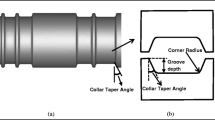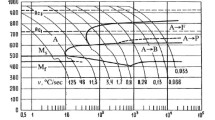Abstract
Optimal selection of wire rope for various industrial applications is a multidisciplinary procedure. In this paper, optimum selection of wire rope for winch trolley in hot rolling shop is comprehensively demonstrated using finite element analysis. Powerfoam wire rope can be operated at lower D/d ratio and have 2.5 times longer service life as compared to their stranded conventional counterpart. The parameter-based geometric models of commercially available multi-layer wire ropes of 1 + 6 + 6 strand construction are designed using modelling software, SolidWorks, and procedure is followed by finite element analysis on ANSYS. The service life of wire rope is a function of factor of safety. Finally, cost analysis is delivered for optimum selection of wire rope, as an economical insight of the study.











Similar content being viewed by others
Abbreviations
- F:
-
Axial tensile force (N)
- Ff :
-
Frictional force b/w rails and wheels (N)
- Fa :
-
Force to accelerate the trolley in horizontal direction (N)
- E:
-
Young modulus of elasticity (N/mm2)
- v:
-
Poisson’s ratio
- amax :
-
Maximum acceleration of winch trolley (m/s2)
- µ:
-
Co-efficient of friction
- σa :
-
Axial stress (N/mm2)
- σb :
-
Bending stress (N/mm2)
- σr :
-
Resultant stress (N/mm2)
- A:
-
Cross-section area of rope (mm2)
- d:
-
Diameter of rope (mm)
- D:
-
Diameter of drum/sheave (mm)
- α:
-
Wire stress tensile factor
- β:
-
Wire stress bending factor
- L:
-
Length of rope (mm)
- Nr :
-
Number of ropes in the system
- dc :
-
Core diameter (mm)
- nw :
-
Number of wires in each strand
- Nls :
-
Number of layers in strand
- Ns :
-
Number of strands
- Lo :
-
Overall length of each geometric model (mm)
- N:
-
Number of failures of rope per year
- Cwr :
-
Annual cost of wire rope (₹)
- Cp :
-
Annual loss of profit (₹)
- Cf :
-
Annual cost of fuel (₹)
- Ce :
-
Annual cost of electricity (₹)
- Co :
-
Annual overheads (₹)
- Sut :
-
Ultimate tensile strength (N/mm2)
- Sy :
-
Yield tensile strength (N/mm2)
- nb :
-
Number of billets in each cycle
- mb :
-
Mass of each billet (kg)
- mt :
-
Mass of winch trolley (kg)
- σmax :
-
Maximum stress in wire rope (N/mm2)
- δmax :
-
Maximum deflection induced in wire rope (mm)
- FOSmin :
-
Minimum factor of safety of wire rope
- FOS16 :
-
FOSmin of 16 mm diameter wire rope
- FOS18 :
-
FOSmin of 18 mm diameter wire rope
- FOS20 :
-
FOSmin of 20 mm diameter wire rope
- L16 :
-
Expected service/operational life of 16 mm diameter conventional wire rope
- Lp16 :
-
Expected service/operational life of 16 mm diameter powerfoam wire rope
- L18 :
-
Expected service/operational life of 18 mm diameter conventional wire rope
- Lp18 :
-
Expected service/operational life of 18 mm diameter powerfoam wire rope
- L20 :
-
Expected service/operational life of 20 mm diameter conventional wire rope
- Lp20 :
-
Expected service/operational life of 20 mm diameter powerfoam wire rope
- ₹:
-
Rupee (Indian currency)
References
Costello, G.A.: Theory of Wire Rope. Springer, Berlin (1997). https://doi.org/10.1016/j.engfailanal.2016.09.002
Wire rope handbook by Usha Martin Pvt. Ltd
Kumar, K., Goyal, D., Banwait, S.S.: Effect of key parameters on fretting behaviour of wire rope: a review. Arch. Comput. Methods Eng. 27(2), 549–561 (2019). https://doi.org/10.1007/s11831-019-09326-y
Feyrer, K.: Wire Ropes (p. 317). Springer, Berlin (2007). https://doi.org/10.1007/978-3-642-54996-0
Singh, R.P., Mallick, M., Verma, M.K.: Studies on failure behaviour of wire rope used in underground coal mines. Eng. Fail. Anal. 70, 290–304 (2016). https://doi.org/10.1016/j.engfailanal.2016.09.002
Krishna, M.M., Shunmugam, M.S., Prasad, N.S.: A study on the sealing performance of bolted flange joints with gaskets using finite element analysis. Int. J. Press. Vessels Pip. 84(6), 349–357 (2007). https://doi.org/10.1016/j.ijpvp.2007.02.001
He, X.: Recent development in finite element analysis of clinched joints. Int. J. Adv. Manuf. Technol. 48(5–8), 607–612 (2010). https://doi.org/10.1007/s00170-009-2306-2
Huang, L., Sheikh, A.H., Ng, C.T., Griffith, M.C.: An efficient finite element model for buckling analysis of grid stiffened laminated composite plates. Compos. Struct. 122, 41–50 (2015). https://doi.org/10.1016/j.compstruct.2014.11.039
Danenko, V.F., Gurevich, L.M., Kushkina, E.Y., Gladskikh, E.B.: New applications of compactedsteel strands and wire rope. Steel Transl. 46(11), 757–763 (2016). https://doi.org/10.3103/S0967091216110048
Phillips, J.W., Costello, G.A.: Analysis of wire ropes with internal-wire-rope cores. J. Appl. Mech. 52(3), 510–516 (1985). https://doi.org/10.1115/1.3169092
Kumar, K., Botsis, J.: Contact stresses in multilayered strands under tension and torsion. J. Appl. Mech. 68(3), 432–440 (2001). https://doi.org/10.1115/1.1355777
Jiang, W.G., Yao, M.S., Walton, J.M.: A concise finite element model for simple straight wire rope strand. Int. J. Mech. Sci. 41(2), 143–161 (1999). https://doi.org/10.1016/S0020-7403(98)00039-3
Sun, J.F., Wang, G.L., Zhang, H.O.: Elasto-plastic contact problem of laying wire rope using FE analysis. Int. J. Adv. Manuf. Technol. 26(1–2), 17–22 (2005). https://doi.org/10.1007/s00170-004-2120-9
Erdine, E., Kallegias, A.: Interwoven reinforced concrete structures: integration of design and fabrication drivers through parametric design processes. Des. Stud. 52, 198–220 (2017). https://doi.org/10.1016/j.destud.2017.06.002
Mathiyazhagan, K., Sengupta, S., Mathivathanan, D.: Challenges for implementing green concept in sustainable manufacturing: a systematic review. OPSEARCH 56(1), 32–72 (2019). https://doi.org/10.1007/s12597-019-00359-2
Oxman, R.: Thinking difference: theories and models of parametric design thinking. Des. Stud. 52, 4–39 (2017). https://doi.org/10.1016/j.destud.2017.06.001
Shim, V.B., Fernandez, J.W., Gamage, P.B., Regnery, C., Smith, D.W., Gardiner, B.S., et al.: Subject-specific finite element analysis to characterize the influence of geometry and material properties in Achilles tendon rupture. J. Biomech. 47(15), 3598–3604 (2014). https://doi.org/10.1016/j.jbiomech.2014.10.001
Love, A.E.H.: A Treatise on the Mathematical Theory of Elasticity. Cambridge University Press, Oxford (2013)
Stanova, E., Fedorko, G., Fabian, M., Kmet, S.: Computer modelling of wire strands and ropes Part I: theory and computer implementation. Adv. Eng. Softw. 42(6), 305–315 (2011). https://doi.org/10.1016/j.advengsoft.2011.02.008
Stanova, E., Fedorko, G., Fabian, M., Kmet, S.: Computer modelling of wire strands and ropes part II: finite element-based applications. Adv. Eng. Softw. 42(6), 322–331 (2011). https://doi.org/10.1016/j.advengsoft.2011.02.010
Beltrán, J.F., Vargas, D.: Effect of broken rope components distribution throughout rope cross-section on polyester rope response: numerical approach. Int. J. Mech. Sci. 64(1), 32–46 (2012). https://doi.org/10.1016/j.ijmecsci.2012.08.005
Xiang, L., Wang, H.Y., Chen, Y., Guan, Y.J., Wang, Y.L., Dai, L.H.: Modeling of multi-strand wire ropes subjected to axial tension and torsion loads. Int. J. Solids Struct. 58, 233–246 (2015). https://doi.org/10.1016/j.ijsolstr.2015.01.007
Fedorko, G., Stanova, E., Molnar, V., Husakova, N., Kmet, S.: Computer modelling and finite element analysis of spiral triangular strands. Adv. Eng. Softw. 73, 11–21 (2014). https://doi.org/10.1016/j.advengsoft.2014.02.004
Van Tran, P., Maegawa, K., Fukada, S.: Experiments and dynamic finite element analysis of a wire-rope rockfall protective fence. Rock Mech. Rock Eng. 46(5), 1183–1198 (2013). https://doi.org/10.1007/s00603-012-0340-0
Cao, X., Wu, W.: The establishment of a mechanics model of multi-strand wire rope subjected to bending load with finite element simulation and experimental verification. Int. J. Mech. Sci. 142, 289–303 (2018). https://doi.org/10.1016/j.ijmecsci.2018.04.051
Onur, Y.A.: Experimental and theoretical investigation of prestressing steel strand subjected to tensile load. Int. J. Mech. Sci. 118, 91–100 (2016). https://doi.org/10.1016/j.ijmecsci.2016.09.006
Meng, F., Chen, Y., Du, M., Gong, X.: Study on effect of inter-wire contact on mechanical performance of wire rope strand based on semi-analytical method. Int. J. Mech. Sci. 115, 416–427 (2016). https://doi.org/10.1016/j.ijmecsci.2016.07.012
Chen, Y., Meng, F.: Numerical study on wear evolution and mechanical behavior of steel wires based on semi-analytical method. Int. J. Mech. Sci. 148, 684–697 (2018). https://doi.org/10.1016/j.ijmecsci.2018.09.030
Sadeghi, H., Davey, K., Darvizeh, R., Darvizeh, A.: A scaled framework for strain rate sensitive structures subjected to high rate impact loading. Int. J. Impact Eng 125, 229–245 (2019). https://doi.org/10.1016/j.ijimpeng.2018.11.008
Salih, S., Davey, K., Zou, Z.: Frequency-dependent cohesive-zone model for fatigue. Int. J. Solids Struct. 152, 228–237 (2018). https://doi.org/10.1016/j.ijsolstr.2018.06.030
Zalnezhad, E., Sarhan, A.A., Jahanshahi, P.: A new fretting fatigue testing machine design, utilizing rotating–bending principle approach. Int. J. Adv. Manuf. Technol. 70(9–12), 2211–2219 (2014). https://doi.org/10.1007/s00170-013-5457-0
Chen, Y., Meng, F., Gong, X.: Study on performance of bended spiral strand with interwire frictional contact. Int. J. Mech. Sci. 128, 499–511 (2017). https://doi.org/10.1016/j.ijmecsci.2017.05.009
Feng, C., Zhang, D., Chen, K., Guo, Y.: Study on viscoelastic friction and wear between friction linings and wire rope. Int. J. Mech. Sci. 142, 140–152 (2018). https://doi.org/10.1016/j.ijmecsci.2018.04.046
Lietch, L.C., Lee, H., Mall, S.: Fretting fatigue behavior of Ti–6Al–4V under seawater environment. Mater. Sci. Eng., A 403(1–2), 281–289 (2005). https://doi.org/10.1016/j.msea.2005.05.047
Kim, S.H., Bae, R.H., Do Kwon, J.: Bending fatigue characteristics of wire rope. J. Mech. Sci. Technol. 26(7), 2107–2110 (2012). https://doi.org/10.1007/s12206-011-1251-9
Peng, Y.X., Chang, X.D., Sun, S.S., Zhu, Z.C., Gong, X.S., Zou, S.Y., et al.: The friction and wear properties of steel wire rope sliding against itself under impact load. Wear 400, 194–206 (2018). https://doi.org/10.1016/j.wear.2018.01.010
Vennemann, O., Törnqvist, R., Ernst, B., Winter, S., Frazer, I.: Bending fatigue tests using a suitable NDT method to determine lifetime of large diameter wire ropes for offshore lifting applications. In: ASME 2008 27th International Conference on Offshore Mechanics and Arctic Engineering (pp. 155–161). American Society of Mechanical Engineers. https://doi.org/10.1115/OMAE2008-57128
Mouradi, H., El Barkany, A., El Biyaali, A.: Steel wire ropes failure analysis: experimental study. Eng. Fail. Anal. 91, 234–242 (2018). https://doi.org/10.1016/j.engfailanal.2018.04.019
Samset, I.: Winch and Cable Systems, vol. 18. Springer, Berlin (2013)
Onur, Y.A., İmrak, C.E., Onur, T.Ö.: Invstigation on bending over sheave fatigue life determination of rotation resistant steel wire rope. Exp. Techniq. 41(5), 475–482 (2017). https://doi.org/10.1007/s40799-017-0188-z
US Navy Wire Rope handbook vol-II. In: Wire Rope Analysis and Design Data (1987)
Shigley, J.E.: Shigley’s Mechanical Engineering Design. Tata McGraw-Hill Education, New York (2011)
Mogale, D.G., Cheikhrouhou, N., Tiwari, M.K.: Modelling of sustainable food grain supply chain distribution system: a bi-objective approach. Int. J. Prod. Res. (2019). https://doi.org/10.1080/00207543.2019.1669840
De, A., Mogale, D.G., Zhang, M., Pratap, S., Kumar, S.K., Huang, G.Q.: Multi-period multi-echelon inventory transportation problem considering stakeholders behavioural tendencies. Int. J. Prod. Econ. 107566 (2019)
Maiyar, L.M., Thakkar, J.J.: Environmentally conscious logistics planning for food grain industry considering wastages employing multi objective hybrid particle swarm optimization. Transp. Res. Part E Logist. Transp. Rev. 127, 220–248 (2019). https://doi.org/10.1016/j.tre.2019.05.006
Gansterer, M., Hartl, R.F.: Collaborative vehicle routing: a survey. Eur. J. Oper. Res. 268(1), 1–12 (2018)
Xie, M., Goh, T.N., Tang, Y.: On changing points of mean residual life and failure rate function for some generalized Weibull distributions. Reliab. Eng. Syst. Saf. 84(3), 293–299 (2004). https://doi.org/10.1016/j.ress.2003.12.005
Author information
Authors and Affiliations
Corresponding author
Ethics declarations
Conflict of interest
The authors declare that they have no conflict of interest.
Additional information
Publisher's Note
Springer Nature remains neutral with regard to jurisdictional claims in published maps and institutional affiliations.
Rights and permissions
About this article
Cite this article
Kumar, K., Singh, S. & Banwait, S.S. Optimum design and selection of wire rope for hot rolling shop applications. OPSEARCH 58, 29–53 (2021). https://doi.org/10.1007/s12597-020-00468-3
Accepted:
Published:
Issue Date:
DOI: https://doi.org/10.1007/s12597-020-00468-3




